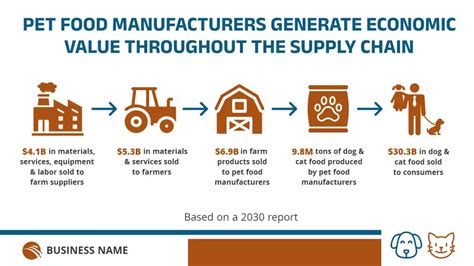Introduction
The global pet food market is expected to reach USD 99.34 billion by 2025, according to a report by Grand View Research. This growth is attributed to the increasing demand for pet food due to the rising pet ownership rates and the growing awareness of pet health and nutrition.

The pet food supply chain is a complex and global system that involves many different stakeholders, including farmers, manufacturers, distributors, and retailers.
Challenges in the Pet Food Supply Chain
The pet food supply chain faces a number of challenges, including:
- Food safety: The safety of pet food is a major concern for pet owners. Pet food can be contaminated with bacteria, viruses, and parasites that can cause illness or even death in pets.
- Sustainability: The pet food supply chain is not sustainable. The production of pet food requires a lot of resources, including land, water, and energy.
- Cost: The cost of pet food is a major concern for pet owners. The price of pet food has been rising in recent years, and this trend is expected to continue in the future.
Trends in the Pet Food Industry
A number of trends are driving the evolution of the pet food industry, including:
- The rise of premium pet food: Pet owners are increasingly demanding premium pet food that is made with high-quality ingredients.
- The growth of e-commerce: Pet owners are increasingly purchasing pet food online.
- The increasing popularity of pet food subscription boxes: Pet food subscription boxes provide pet owners with a convenient and affordable way to get high-quality pet food delivered to their door.
The Future of the Pet Food Industry
The future of the pet food industry is bright. The demand for pet food is expected to continue to grow in the coming years, and this growth will be driven by the increasing number of pet owners and the growing awareness of pet health and nutrition.
The pet food industry is also expected to become more sustainable in the future. Pet food manufacturers are increasingly using sustainable ingredients and packaging, and they are also investing in renewable energy sources.
How to Improve the Pet Food Supply Chain
There are a number of ways to improve the pet food supply chain, including:
- Increasing transparency: Pet food manufacturers need to be more transparent about their sourcing and production practices.
- Investing in sustainability: Pet food manufacturers need to invest in sustainable practices to reduce the environmental impact of the pet food supply chain.
- Reducing costs: Pet food manufacturers need to find ways to reduce the cost of pet food without sacrificing quality.
Tips for Pet Owners
Pet owners can also play a role in improving the pet food supply chain by:
- Buying pet food from reputable sources: Pet owners should only buy pet food from reputable sources that have a good track record of producing safe and high-quality pet food.
- Reading the pet food label: Pet owners should carefully read the pet food label to make sure that the food is appropriate for their pet’s age, health, and activity level.
- Storing pet food properly: Pet owners should store pet food in a cool, dry place to prevent it from becoming contaminated.
Conclusion
The pet food supply chain is a complex and global system that faces a number of challenges. However, the future of the pet food industry is bright, and there are a number of ways to improve the pet food supply chain. By working together, pet food manufacturers, retailers, and pet owners can create a more sustainable, affordable, and transparent pet food supply chain.
Tables
| Year | Pet Food Market Value (USD Billion) |
|---|---|
| 2020 | 90.40 |
| 2021 | 94.15 |
| 2022 | 97.93 |
| 2023 | 101.78 |
| 2025 | 110.24 |
| Country | Pet Food Market Value (USD Billion) |
|---|---|
| United States | 38.54 |
| China | 15.12 |
| Brazil | 8.57 |
| Germany | 7.32 |
| France | 6.54 |
| Pet Food Type | Market Share (%) |
|---|---|
| Dry Food | 70.2 |
| Wet Food | 22.1 |
| Treats and Snacks | 7.7 |
| Pet Food Ingredient | Market Share (%) |
|---|---|
| Meat | 50.3 |
| Grains | 28.7 |
| Vegetables | 12.1 |
| Fruits | 8.9 |





















